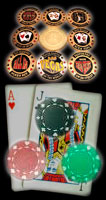SHORT-HANDED GAMES
Short-handed games are fast-paced, aggressive games.
Passive play is generally always losing play.
In short-handed games, passive play is a very fast way to lose You won’t go far wrong if you play a five-handed game as if it were a ten-handed game where the first five players have folded.
You won’t go far wrong if you use that approach, but you will go wrong.
The distribution of hands in a short-handed game will be about the same as the distribution of hands in a full game where the first few players have folded.
It’s not exact, but it’s close. The difference is that the blinds are moving around much faster in a short-handed game.
The initial amount of money in the pot in the form of the blinds is the same whether it’s a ten-handed game or a five-handed game, but in the short-handed game, the average amount each player is contributing is twice what it is in a full game.
The effect of that is to increase the importance of winning more than your share of the blinds.
The major strategiesy adjustment for a short-handed game is to play slightly looser and a lot more aggressively than you would in a full game with the same position.
Continue this strategy after the flop. Semi-bluff draws aggressively.
Play the top pair as a very strong hand, and play the second and even third pair as a strong hand.
Unrelenting aggression is the key to winning at short-handed games.
Pick the Right Table / Picking a Seat / Theories of Poker / Betting Theory : The Odds
A Theory of Starting Hand Value
A Theory of Flop Play : Counting Outs and Evaluating Draws
The Dynamics of Game Conditions / Table Image / Player Stereotypes
Women and Poker / Spread-Limit Games / Double Bet on the End Games / Kill Games



